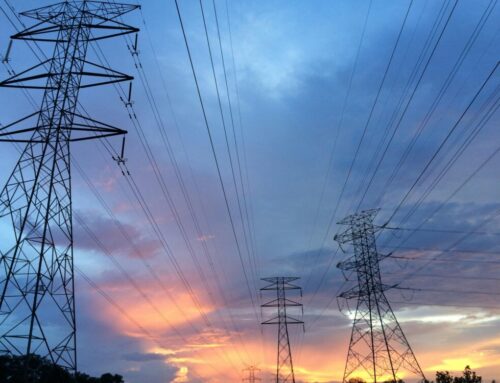Article by , published on Wed, June 14, 2023 in Yahoo!News
 The Electric Reliability Council of Texas anticipates record-breaking peak electricity demand of 82,739 megawatts this summer, according to the Summer 2023 Seasonal Assessment that ERCOT published in May.
The Electric Reliability Council of Texas anticipates record-breaking peak electricity demand of 82,739 megawatts this summer, according to the Summer 2023 Seasonal Assessment that ERCOT published in May.
With the season only a week away and record temperatures expected, Texans may be worried the power grid can’t handle the heat.
Last year, Texans were asked to conserve energy after six power plants went offline amid a heat wave. In May and June 2021, Texas experienced solar farm shutdowns, which disrupted power plants, interfered with grid recovery operations and caused outages of power units.
ERCOT issued a weather watch earlier this week, cautioning that an expected heat wave could strain Texas’ power grid. The watch begins Thursday and runs through June 21, when the temperature is expected to reach 106, according to the National Weather Service.
Can the Texas power grid handle record demand for electricity?
In its seasonal assessment, ERCOT concluded that the grid has enough generation capacity to avoid rolling blackouts between June and September under typical summer weather conditions. Over 97,000 megawatts are expected to be available for the summer peak load, ERCOT says. There’s a reserve margin of 23%, an improvement from the last two years.
“Assuming that the ERCOT Region experiences typical summer grid conditions, ERCOT anticipates that there will be sufficient installed generating capacity available to serve the system-wide forecasted peak load for the upcoming summer season, June – September 2023,” the ERCOT summer report reads.
The primary worry, however, is that some of the thermal power plants Texans are counting on will break down, Ed Hirs, an energy economist at the University of Houston, told the Star-Telegram. The coal power plants average 50 years in age, and the natural gas power plants average 30 years. If too many go offline when they are needed, then we can expect rolling blackouts to be implemented, especially if there is a major weather disruption that reduces wind and solar resources.
“The odds of this happening are bigger than zero, and more likely than last year,” Hirs explained.
Hirs says that thermal resources — natural gas power plants, coal power plants and nuclear power plants — are essentially unchanged from last year. There has been practically no growth in thermal resources for more than ten years, he says.
ERCOT will need to rely on wind and solar power to meet demand during the hottest days this summer, he said.
“Fortunately, the burgeoning growth of solar farms is good for the grid during the cloudless, hot days of summer,” Hirs says. “But as we know, the hottest days of the summer are also those when the wind does not blow, and so there are potential shortfalls from the wind farms.”
NERC estimates that ERCOT has a 4% risk of Energy Emergency Alert Level 1 in Summer 2023, meaning the operating margin has dropped below 2,300 megawatts. That risk increases up to 19% in the evening due to reduction in solar generation.
Texas has enough electricity for a normal summer. How about a heatwave?
While concern about the lights staying on is warranted, there’s been some positive progress in the last year. The North American Electric Reliability Corporation found that Texas is experiencing strong growth in both power resources and demand. The state has enough capacity to generate electricity for a normal summer, but its reserves could be sorely tested during a prolonged heatwave, according to the study.
ERCOT added over four gigawatts of solar-generated power to the ERCOT grid since 2022. Also, load reductions from dispatchable demand response programs have grown by over 18%, totaling 3,380 megawatts. Meanwhile, this is offset by the fact that ERCOT’s peak demand forecast has risen by 6% as a result of economic growth. There is a risk that dispatchable generation can be insufficient for high demand levels when wind output is unusually low, states the report.
“Resources are adequate for peak demand of the average summer; however, dispatchable generation may not be sufficient to meet reserves during an extreme heat-wave that is accompanied by low winds,” NERC says.
The assessment finds that, while resources are adequate for normal summer peak demand, if summer temperatures spike, ERCOT may face supply shortages during higher demand levels. The risk of high temperatures may challenge system resources and result in emergency procedures, including the need for cutting off or reducing electricity supply during periods of low wind and high generator outages, according to NERC.
Will Summer 2023 be hotter than normal?
There’s a high probability that we’ll have a hotter than normal summer in the Lone Star State.
The Climate Prediction Center projects a 50-60% chance that most of Texas will have a warmer than normal summer, while West Texas has a 60-70% chance of above normal temperatures and North Texas has a 33-50% chance.
Why is there such high electricity demand in Texas?
Hirs says the main reason for the record demand is that the Texas economy continues to grow.
Population growth and economic growth are driving the need for more electricity in Texas. Peak electricity demand last summer hit 80 gigawatts. This week, with 100 degree temperatures, ERCOT forecasts that we may see a peak demand of 83 gigawatts.
What can Texans expect from their electricity providers this summer?
It’s likely that ERCOT will ask Texans to conserve energy this summer by turning thermostats to 78 degrees and avoiding use of appliances during peak hours, Hirs said.
Be prepared for outages, Hirs said, not just because of a shortage of generation capacity, but because of storms disrupting local service. Have plenty of bottled water handy in case the electricity to the local water utility is disrupted, he suggests.
“A blackout anywhere in the infrastructure can cause problems at home with water, traffic lights, gasoline pumps, cellphones, healthcare, etc.,” he said.





